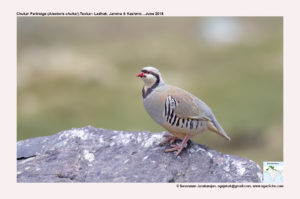
Chukar Partridge Alectoris Chukar
Etymology :
- Alectoris : Greek word for Chicken, Farm fowl
- Chukar : Hindi name Chukor for Chukar Partridge
Vernacular Names :Persian, Baluchistan: Kabk, Turki: Keklik, Pushtu: Zarkar, Hindi: Chukor, Kash: Kakov, H.P.: Chakru
Distribution in India: Resident in Himalayas.
Description: Size of 37-38 cm, wt. of male 504–800 g, female 450–680 g; wingspan 47–52 cm. It is a light brown back, grey breast, and buff belly. The shades vary across the various populations. The face is white with a black stripe running from the eye to the creamy white throat forming a black gorget. It has rufous-streaked flanks, red legs and coral red bill. Sexes are similar, the female slightly smaller in size and lacking the spur.The tail has 14 feathers.
Habitat: Found in bare stony slopes with short grass, sparsely covered with short shrubs ,semi-arid and arid areas, from low plains and even sea-level up to 5000 m in Himalayas.
Food Habits: It eats bulbous roots, grain and shoots of grass and cereals, berries, and insects including their eggs. During periods of high rainfall, grass seeds dominate diet, and during hard winters birds dig extensively for bulbs and rhizomes.
Breeding Habits: They breed in April-July in India. They are monogamous. The nest is a scrape sometimes lined with grass, leaves, etc.; under cover, such as bush, trees or overhanging grass. Re-nesting is common if first attempt fails, with males sometimes forming new pair-bond in such cases. They lay a clutch of 7-12 pale eggs ,laid at 1–2-day intervals. The incubation period is 22-25 days, commenced with last egg done by female alone. The chicks are cared for by both adults; young are capable of very short flights at 7–10 days. Female sometimes produces two clutches, one of which will be incubated by male.